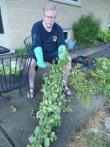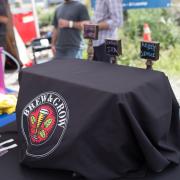From my blog https://singingboysbrewing.com/blog/workshop-on-belgian-beer-styles-and-evaluation
Earlier this month, I led the second of four monthly workshops that started out as preparation for those taking the Beer Judge Certification Program’s Beer Evaluation Exam I’m administering in January. The workshops have grown, though, to include others who are interested in learning more about beer tasting and evaluation.

At each workshop, we focus on one ‘family’ of related beers styles, talking through the styles, helping the participants relate one style to another and put them into a framework, and tasting examples of four of the styles. For the first style we taste, we talk through our evaluation, and for the other three, the participants and I fill out a BJCP scoresheet. Then we go around the room and share what we wrote, responding and critiquing as appropriate.
For the first workshop, we had a big group of about 15, which was great but also made in depth conversation a little more challenging – it was more about my presenting and less about discussion. So, for the second workshop, I divided the group into two different evenings and it worked well – the quality of the discussion about the beers we tasted and our evaluation of them improved significantly.
This workshop focused on non-sour Belgian beers – Witbier, Belgian Pale Ale, Bier de Garde, Saison, Belgian Blonde, Belgian Golden Strong, Trappist Single, Dubbel, Tripel, and Belgian Dark Strong styles. We didn’t have any handmade versions of the styles available, so we tasted some very good commercial examples.

We started with Tripel Karmeliet brewed by Brouwerij Bosteels, which was wonderful in many ways but our example showed a little bit of age with some notable oxidation. We then followed it with Delerium Tremens, a Belgian Golden Strong Ale and one of my very favorite beers. Dry, crisp, effervescent and deceptively strong.
We moved on to Trappist ales, tasting and evaluating Chimay Première, an example of the Dubbel style and then finished with its ‘big brother’, the larger, more complex Belgian Dark Strong. The example we tasted was St. Bernardus Abt 12, redolent of pit and dried fruit and fantastically delicious.
As a group, folks made great progress from the first workshop in focusing in on describing their perceptions and less about whether they liked something or their personal preferences. Most also were doing a good job in both qualifying and quantifying their perceptions. We focused some on digging deeper into descriptors and memories that aromas or flavors triggers for us - what kind of dark fruit does that aroma remind you of?
One element we’re going to have to continue to work on is to look at balance in the beers, along multiple axes – this is a key in describing or evaluating beers. Most commonly, we think of balance between malt and bitterness, which is an important component of almost any beer. But there are other flavor and aroma components whose balance can offer insight into the beer – for example, in the Tripel and Golden Strong from this workshop, the relative levels and balance between fruity esters and spicy phenols was one factor that distinguished the two beers.
The November workshop will focus on some English styles as well as some comparison to their American counterparts – English versus American Barleywine, for example.








